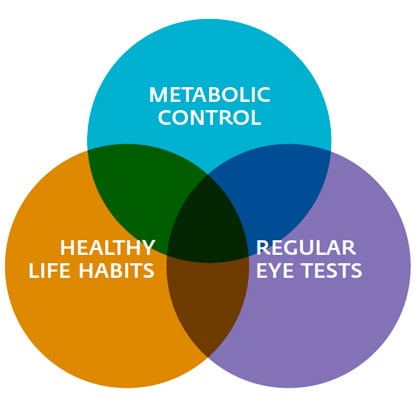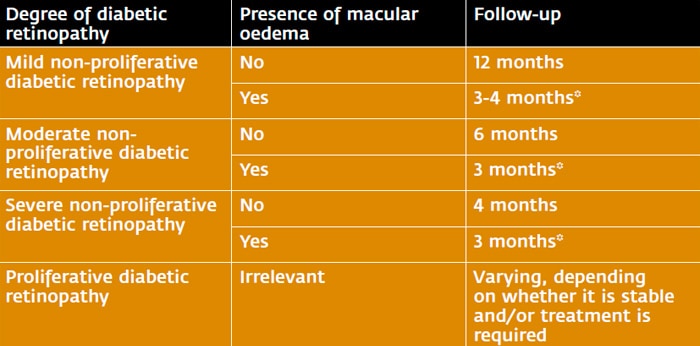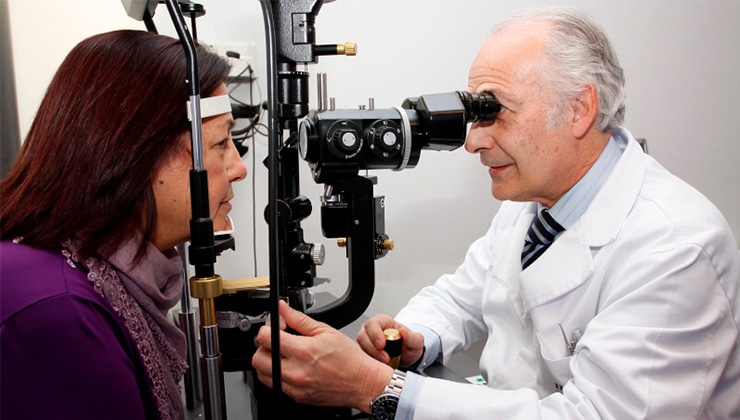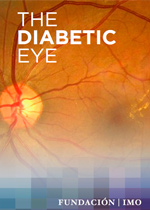L’ull diabètic. Guia de prevenció de la salut ocular en pacients amb diabetis
12 de April de 2022
About the guide
Content
- Diabetic retinopathy
- Why does it occur?
- How to deal with diabetic retinopathy
- Symptoms
- Prevention
- Recommended visits schedule
- Comprehensive approach
- Treatment
Diabetic retinopathy
Diabetes is a highly prevalent disease affecting 13% of the Spanish population that is increasing and hence becoming the most frequent metabolic disease. Bad monitoring of the pathology, which usually evolves slowly and silently, can result in complications seriously affecting the quality of life of these patients, whose risk of severe vision loss is 25 times higher than that of the remaining population.
One of the main complications of diabetes is diabetic retinopathy, a disease that has become the main cause of irreversible blindness at a working age in industrialised countries, although it is avoidable in 90% of cases, if treated early and appropriately. It is estimated that more than half of patients who have suffered from diabetes for 15 or more years have some degree of retinal vascular disorder and almost all with a history of more than 30 years show signs of diabetic retinopathy. To slow down its appearance or improve its prognosis, it is essential that patients get involved.

How to deal with diabetic retinopathy
Regular examinations (at least annually) of the retina are essential, which, together with a strict metabolic control and the adoption of healthy habits, avoid important losses of vision due to diabetes.
To slow down the appearance of diabetic retinopathy or improve its prognosis, it is essential that patients get involved. Specialists recommend:
- Carrying out a strict metabolic control of the risk factors: glycemia, blood pressure and plasma lipids
- Adopting healthy life habits and avoiding obesity, a sedentary life style and tobacco consumption
- Having the fundus tested once a year and intensifying eye examinations, if a problem is detected, as indicated by the specialist
Recommended visits schedule
Overall, this is the schedule of ophthalmological visits recommended for diabetic patients, depending on the type of diabetes, the lapse of evolution and the degree of diabetic retinopathy (with or without macular oedema):

No suspected diabetic retinopathy

With diabetic retinopathy
(*) If no treatment is required.
Comprehensive approach
In addition to patient involvement, cooperation between ophthalmologists, optometrists, endocrinologists and diabetes teachers is also key for a comprehensive management of the disease and its ocular complications, hence preventing them from reaching severe stages.
Treatment
Depending on the affected area and the degree of development of the disease, there are different treatment options:
- Laser photocoagulation for the treatment of proliferative retinopathy and some macular oedemas.
- Vitrectomy: surgery that removes the vitreous gel and is used in case of dense vitreous haemorrhage and/or traction on the retinal level.
- Intravitreal injections: drugs are injected locally into the vitreous humour to reduce diabetic macular oedema. Currently, there are different types of drugs.

The progression of diabetic retinopathy is avoidable in 90% of cases, if treated early and appropriately.
IMO Institute of Ocular Microsurgery
Josep María Lladó, 3
08035 Barcelona
Phone: (+34) 934 000 700
E-mail: international@imo.es
See map on Google Maps
By car
GPS navigator coordinates:
41º 24’ 38” N – 02º 07’ 29” E
Exit 7 of the Ronda de Dalt (mountain side). The clinic has a car park with more than 200 parking spaces.
By bus
Autobus H2: Rotonda de Bellesguard, parada 1540
Autobus 196: Josep Maria Lladó-Bellesguard, parada 3191
Autobuses H2, 123, 196: Ronda de Dalt – Bellesguard, parada 0071
How to arrive at IMO from:
IMO Madrid
C/ Valle de Pinares Llanos, 3
28035 Madrid
Phone: (+34) 910 783 783
See map in Google Maps
Public transport
Metro Lacoma (líne 7)
Autobuses:
- Lines 49 & 64, stop “Senda del Infante”
- Line N21, stop “Metro Lacoma”
Timetables
Patient care:
Monday to Friday, 8 a.m. to 9 p.m.
IMO Andorra
Av. de les Nacions Unides, 17
AD700 Escaldes-Engordany, Andorra
Phone: (+376) 688 55 44
See map in Google Maps
IMO Manresa
C/ Carrasco i Formiguera, 33 (Baixos)
08242 – Manresa
Tel: (+34) 938 749 160
See map in Google Maps
Public transport
FGC. Line R5 & R50 direction Manresa. Station/Stop: Baixador de Manresa
Timetables
Monday to Friday, 09:00 A.M – 07:00 PM





